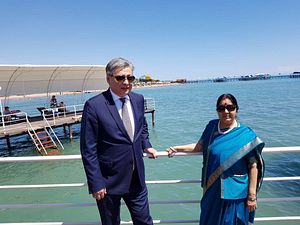Analysis of India’s Connect Central Asia Policy — first unveiled in Bishkek in 2012 — has largely centered on opportunities from expansion of trade, cooperation on infrastructure projects, and joint military training. While ties with Central Asia’s economies and energy sectors are certainly important for India, which fears losing access to the region as China and Russia dig in deeper, efforts in cultural exchange and education are also crucial for understanding India’s ambitions in the region. Following Prime Minister Narendra Modi’s global tour in 2015, which included stops across Central Asia, India has made a push to build the country’s image globally by putting its soft power to work.
Bollywood does a lot of the heavy lifting for average people’s perceptions of India across the world, and Central Asia is no exception. Indian movies first became popular in the Soviet Union in the 1950s, and people who grew up watching classics like Shri 420 or Disco Dancer remember the plots and songs fondly. On a visit to Tashkent earlier this month, India’s External Affairs Minister Sushma Swaraj was shocked when an older Uzbek woman approached her on the street to sing a classic from a well-known Bollywood film. External Affairs Ministry spokesman Raveesh Kumar posted a clip of the interaction on Instagram, writing, “Bollywood knows no boundaries! More so in Uzbekistan where Raj Kapoor and Nargis are household names.”
Contemporary Indian movies and soap operas continue to attract fans. Satellites bring dramas like Zhenskaya Dolya (Kumkum Bhagya) and Lyubimyi Zyat’ (Jamai Raja) to TV screens every morning. Even families without access to Russian or Indian channels could watch Kelin (Balika Vadhu), a soap opera depicting the lives of two generations of child brides, as the show was dubbed in Kazakh and Kyrgyz and broadcast on local TV channels. After five years, Kelin stopped airing, but fans have kept up with the show by trading ripped DVDs sold in bazaars across the region.
As India’s TV and film industries churn out pop culture gems, the government also organizes several cultural and educational exchange programs. The Indian Council for Cultural Relations funds the translation of Indian poems into Central Asian languages, co-sponsors cultural festivals, and funds dance and musical troupes’ tours around the region. Central Asian states have benefited from the Indian Technical and Economic Cooperation (ITEC) Program, which offers training courses, infrastructure-related cooperation, and disaster relief to 161 countries. Since the early 1990s, thousands of people from Central Asia have attended professional development trainings and earned scholarships to study at Indian universities. Even Turkmenistan, known for its isolation, sends 20 young professionals to India every year through ITEC.
India doesn’t only take in students from Central Asia, however; educational exchange has gone in both directions, as thousands of Indian students came to Central Asia to pursue medical degrees. In recent years, the number of Indian medical students in Central Asia has shot up impressively. As of 2018, embassies in the region estimate anywhere from 900 students in Tajikistan to 4,500 in Kyrgyzstan. Exact numbers are difficult to pin down, however, given poor enforcement of enrollment caps and monitoring of approved campuses.
Despite the popularity of Indian movies and television shows in the region, some Indian students have struggled to fit in. In Kyrgyzstan, Indian students in major cities have described a range of upsetting encounters, including open staring and racist comments. Cholpon Uzakbaeva, a PR specialist for the NGO Ruka v Ruke, wrote in a column for Sputnik.kg about how meeting “Gigi,” a fifth-year medical student from Delhi, changed her perception of Kyrgyzstan’s sizable Indian community. Gigi studies at the Asian Medical Institute in Kant, a mid-sized town about an hour east of Bishkek. There, according to Uzakbaeva, “Many [locals] are irritated by the smell of incense these students use, their manner of speaking loudly, and their lack of Russian.”
Unfortunately, the vulnerability of Kyrgyzstan’s Indian student community extends past uncomfortable social interactions. In addition to reports of regular police harassment, students at several universities in Kazakhstan and Kyrgyzstan have complained of extortion.
Tension between Indian medical students and locals has brewed, in Kyrgyzstan more than neighboring countries, despite high-level diplomatic efforts to extend India’s soft power in the region. Fortunately, the Embassy-run cultural centers are well-positioned to provide a bridge between students and locals, and happy stories of welcoming reception and smooth integration exist and should be amplified. This serves as an important reminder that geopolitics plays out at multiple scales, not only between state leaders but all the way down to the interpersonal level.

































